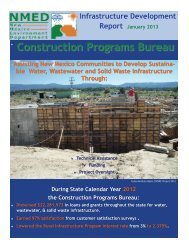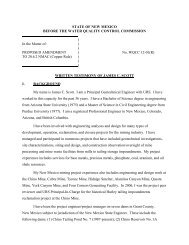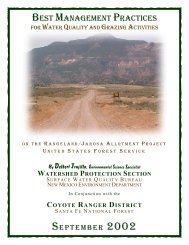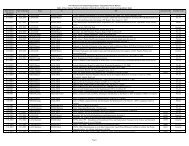Upper Gila Watershed, Taylor Creek - New Mexico Environment ...
Upper Gila Watershed, Taylor Creek - New Mexico Environment ...
Upper Gila Watershed, Taylor Creek - New Mexico Environment ...
You also want an ePaper? Increase the reach of your titles
YUMPU automatically turns print PDFs into web optimized ePapers that Google loves.
Identification of Causes and Sources of Impairments<br />
<strong>Upper</strong> <strong>Gila</strong>, <strong>Taylor</strong> <strong>Creek</strong><br />
<strong>Watershed</strong> Restoration Action Strategy<br />
July 2005<br />
Fire suppression, logging, mining,<br />
grazing, recreation, upstream<br />
impoundment, and road construction<br />
are potential pollution sources that<br />
have or may have contributed to the<br />
current condition of the watershed. In<br />
some cases the significance of impacts<br />
from potential sources is still<br />
undetermined. There is scientific<br />
documentation and anecdotal<br />
information related to historic<br />
watershed impacts and there is value in<br />
recognizing cumulative impact to the<br />
current state of the watershed. Many stakeholders including the GNF believe the policy<br />
of “total fire suppression” practiced over the last 90 years has had a significant impact to<br />
watershed health and surface water quality, the GNF has and is making strides towards<br />
using fire as a management tool. Peer reviewed scientific studies regarding fire ecology<br />
indicate that fire suppression policy has led to an eruption of upland woody species and<br />
decline of both the amount and diversity of herbaceous plants. Although not all<br />
stakeholders agree, some stakeholders believe that current public lands policy limiting<br />
multiple use and accessibility to harvest material such as firewood and timber products<br />
have also contributed to increased tree density in the uplands.<br />
According to the GNF, much of the<br />
forested acreage in this watershed<br />
has tree densities exceeding<br />
recommendations for this area.<br />
The <strong>New</strong> <strong>Mexico</strong> State Forestry<br />
average recommendation is 60 sq.<br />
ft. per acre of basal area but most<br />
areas that were assessed averaged<br />
from 80 to 200 sq. ft. per acre of<br />
basal area. The Northern Arizona<br />
University Ecological Restoration<br />
Institute studies of fire history and<br />
current conditions have shown an<br />
average of 35-50 trees per acre but current densities range from 100-400 trees per acre.<br />
Thus inventory and analysis of vegetation in this watershed indicate an excess of<br />
recommended tree density. A project report prepared by Northern Arizona University on<br />
a thinning demonstration adjacent to the <strong>Taylor</strong> <strong>Creek</strong> watershed is included in the<br />
Appendix. In the watershed, upland woody species are encroaching into the riparian<br />
corridor to the detriment of narrow leaf cottonwood, willow, and other riparian woody<br />
and herbaceous species.<br />
6 of 22









